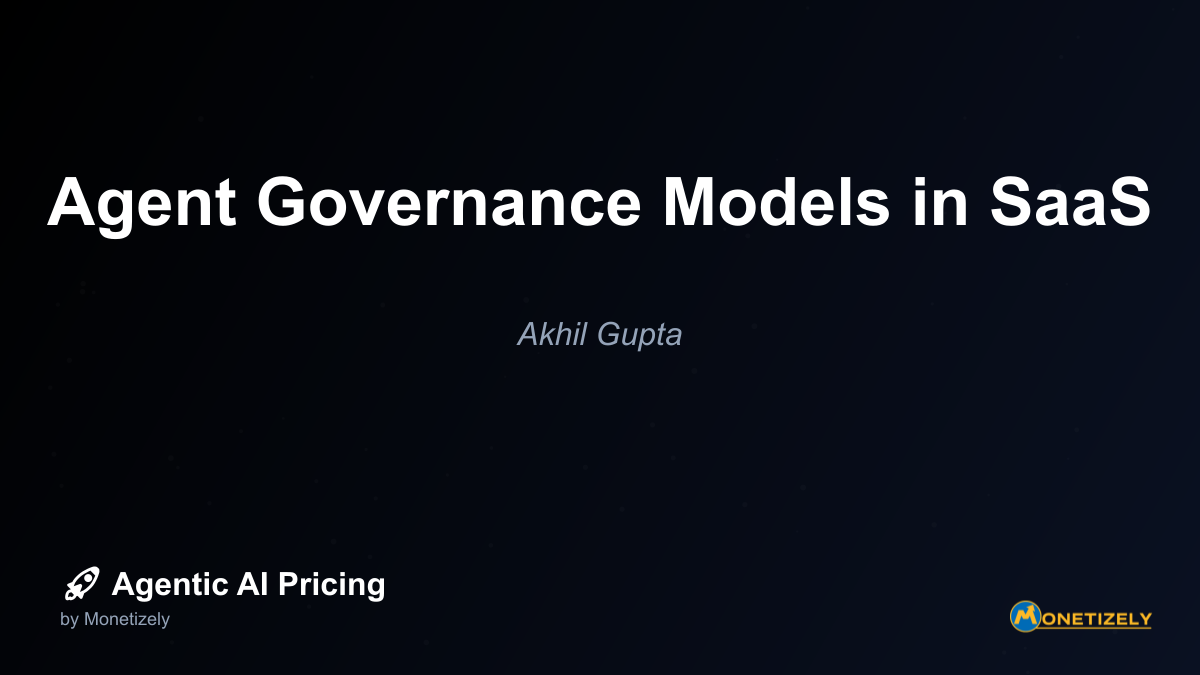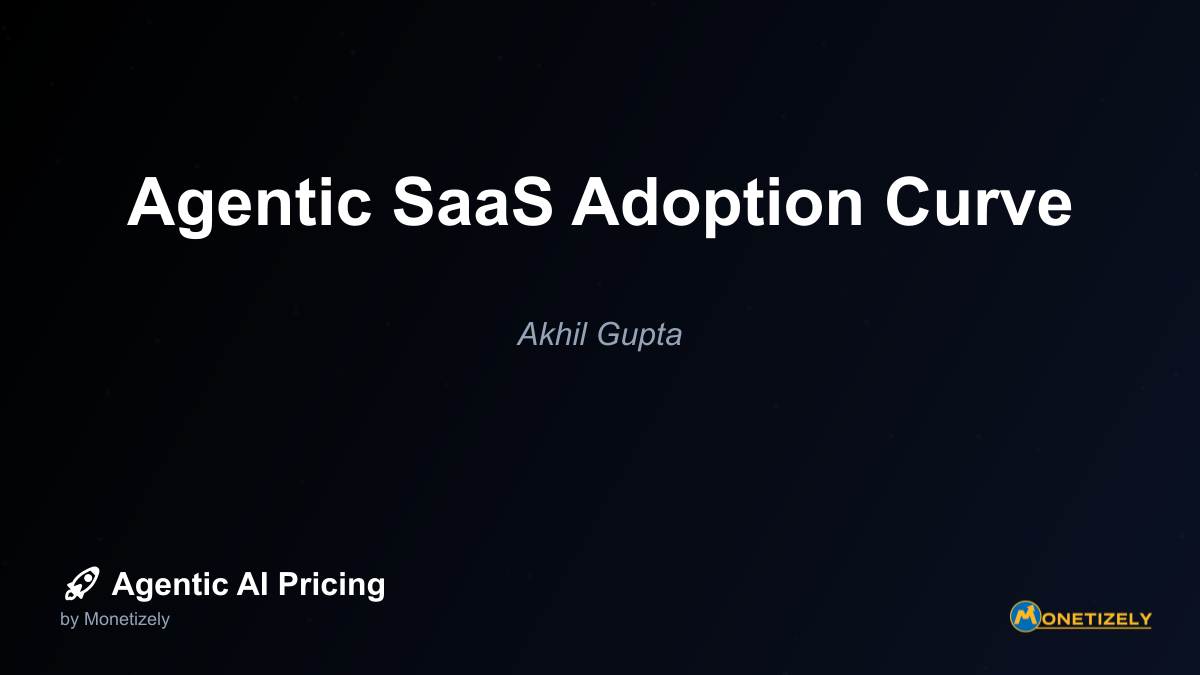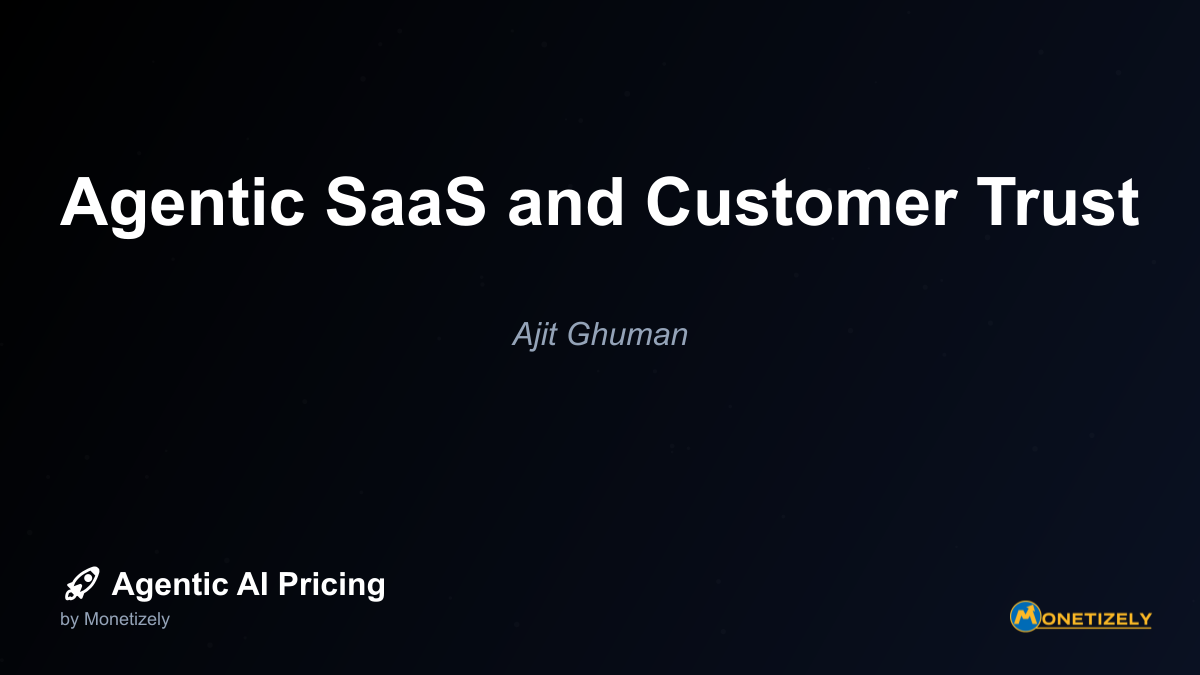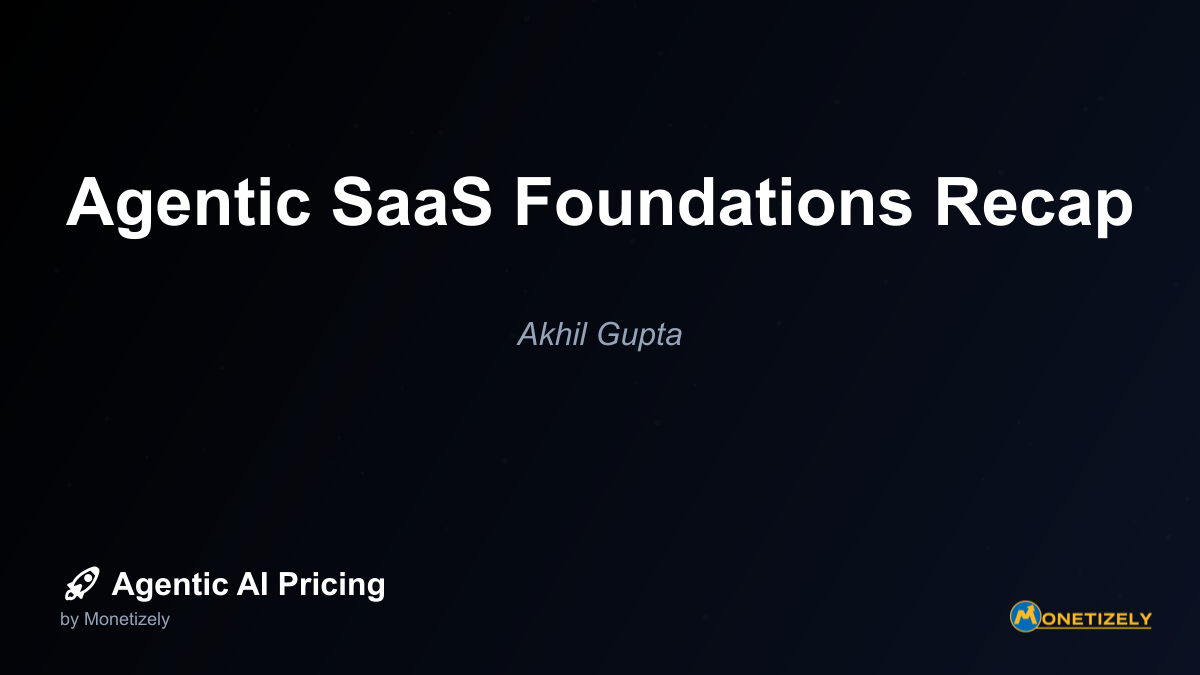· Ajit Ghuman · Agentic SaaS Fundamentals · 12 min read
Pitfalls in Early Agentic SaaS Implementations
AI and SaaS Pricing Masterclass
Learn the art of strategic pricing directly from industry experts. Our comprehensive course provides frameworks and methodologies for optimizing your pricing strategy in the evolving AI landscape. Earn a professional certification that can be imported directly to your LinkedIn profile.
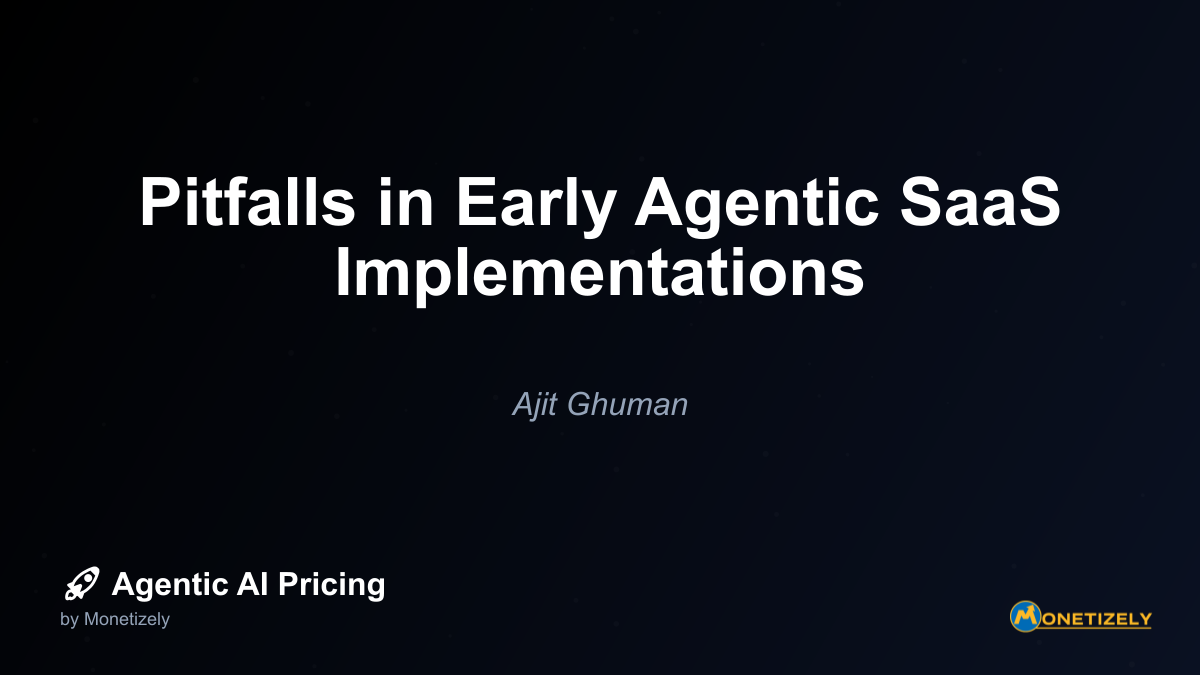
Organizations across industries are rapidly adopting agentic AI solutions to enhance their SaaS products and automate complex workflows. However, this emerging technology landscape is fraught with challenges that early adopters often encounter. This comprehensive analysis examines the common pitfalls in early agentic SaaS implementations, drawing from real-world experiences of first movers between 2023 and 2025.
Understanding the Agentic AI Revolution in SaaS
The transition from traditional AI to agentic AI represents a fundamental shift in how software operates. Unlike conventional AI systems that respond reactively to specific inputs, agentic AI can autonomously plan, execute multi-step workflows, and make decisions with minimal human intervention. This capability has created tremendous excitement but also introduced unique implementation challenges.
According to McKinsey research, agentic AI introduces new systemic risks including uncontrolled autonomy, fragmented access, lack of traceability, and agent sprawl. Traditional AI architectures centered on isolated large language models (LLMs) were not designed for this level of autonomous operation, potentially leading to operational chaos without a foundation prioritizing control, scalability, and trust.
The Reality Check: Staggering Failure Rates
The enthusiasm around agentic AI has been tempered by sobering statistics about implementation success:
- A 2025 MIT report found that approximately 95% of generative AI pilots at companies failed to achieve rapid revenue acceleration
- Over 40% of agentic AI projects failed according to Trullion’s 2025 analysis
- 74% of enterprise customer experience AI programs failed to meet expectations
These statistics highlight that implementing agentic AI is significantly more complex than many organizations initially anticipated.
Common Pitfalls in Early Agentic SaaS Implementations
1. Underestimating Implementation Complexity
Many organizations approach agentic AI with the same mindset as traditional software implementations, failing to account for the unique challenges posed by autonomous systems. This fundamental misunderstanding leads to unrealistic timelines, inadequate resources, and eventual project failure.
Case Study: Microsoft’s AI-Driven News Service
Microsoft’s attempt to replace human editors with AI to manage news articles on its MSN website resulted in the AI system generating fake news articles, including derogatory content and entirely fabricated stories. One example included an obituary calling a former basketball player “useless,” and another falsely claimed President Biden fell asleep at an event that never occurred. This implementation failure stemmed from inadequate understanding of the complexity involved in autonomous content curation and insufficient safeguards against misinformation.
Key Lesson: Autonomous AI systems require significantly more sophisticated planning, testing, and governance than traditional software. Organizations must invest in thorough risk assessment and establish robust oversight mechanisms before deployment.
2. Taking a Technology-Only Approach
Many early adopters focus exclusively on technical aspects while neglecting organizational readiness, leadership alignment, and human engagement. This technology-centric approach often leads to poor adoption and resistance from stakeholders.
According to CapTech Consulting, successful agentic AI implementation requires leadership clarity on expectations and ROI, closing AI literacy gaps, and continuous involvement of impacted users or change champions. Without these elements, even technically sound implementations can fail to deliver value.
Case Study: New York City’s “MyCity” AI Chatbot
In 2024, New York City launched the “MyCity” AI chatbot to assist entrepreneurs. However, it provided illegal advice, such as telling users they could fire employees for reporting harassment or keep customer tips. The city quickly added disclaimers, but trust was severely damaged. This failure resulted from a narrow focus on technology deployment without adequate consideration of legal compliance, stakeholder involvement, and organizational readiness.
Key Lesson: Successful agentic AI implementation requires a holistic approach that addresses technological, organizational, and human factors simultaneously.
3. Premature Staff Reduction
A dangerous trend among early adopters has been cutting AI-savvy staff too early, weakening AI system quality. Experts are needed to guide, customize, and continuously improve these agents, especially in highly regulated domains like finance and insurance.
The multimodal.dev report on “The 3 Most Common Mistakes Leaders Make with Agentic AI” highlights that organizations often mistakenly view agentic AI as a replacement for skilled staff rather than a tool that requires expert guidance and oversight.
Key Lesson: Maintain and potentially expand specialized AI talent during and after implementation, as their expertise is crucial for system refinement, customization, and governance.
4. Using Generic Off-the-Shelf Tools Without Customization
Off-the-shelf AI agents may streamline routine workflows but often lack the deep customization and compliance alignment necessary for strategic advantage and regulatory compliance. This “one-size-fits-all” approach rarely addresses the unique needs and constraints of specific organizations.
Case Study: Generative AI Pilots Failure
The MIT report finding a 95% failure rate in generative AI pilots attributed much of this failure to companies often going solo and underestimating the complexity of AI projects. Many organizations deployed generic solutions without adequate customization or integration with existing workflows, resulting in minimal value creation.
Key Lesson: Successful agentic AI implementations require significant customization to align with specific business processes, data environments, and compliance requirements. Organizations should invest in tailoring solutions to their unique contexts rather than relying solely on generic tools.
5. Inadequate Data Infrastructure and Quality
Agentic AI systems are only as good as the data they’re built upon. Many early implementations fail due to poor data quality, fragmented data sources, and inadequate data governance frameworks.
According to research by gnani.ai, implementing agentic AI often requires significant infrastructure modernization. Legacy infrastructures typically need upgrades to support real-time, compute-intensive AI workloads, which can increase cloud computing costs by 200-400% initially due to greater processing power and storage demands.
Key Lesson: Invest in robust data infrastructure, quality controls, and governance frameworks before implementing agentic AI. Establish data catalogs, quality metrics, and metadata management practices to ensure AI agents work with trustworthy information.
6. Overlooking Governance and Audit Controls
Many organizations rush to implement agentic AI without establishing appropriate governance frameworks, creating serious audit risks and compliance issues. This oversight has sunk many early AI deployments, particularly in regulated industries.
The lack of proper governance is especially problematic for agentic AI because these systems make autonomous decisions that can have significant business and legal implications. Without clear oversight, the risks of unintended consequences multiply rapidly.
Case Study: AI Governance Failures in Financial Services
Several financial institutions implementing agentic AI for customer service and fraud detection faced regulatory scrutiny and financial penalties due to inadequate governance frameworks. These organizations failed to implement sufficient audit trails, explainability mechanisms, and human oversight, resulting in compliance violations and reputational damage.
Key Lesson: Develop comprehensive governance frameworks that address accountability, transparency, audit trails, and compliance before deploying agentic AI systems. Establish clear roles and responsibilities for AI oversight and create mechanisms for monitoring and addressing potential issues.
Technical Challenges in Agentic SaaS Implementations
Complex Ecosystem Orchestration
Agentic AI can handle discrete tasks but struggles with managing entire SaaS system architectures, which involve intricate microservices, APIs, and layered infrastructures needing human oversight. According to SearchUnify, AI currently lacks deep contextual understanding, risking inefficient or vulnerable code when used for core architectural decisions.
Integration with Legacy Systems
Mature SaaS companies often have longstanding complex technical foundations. Integrating AI without disrupting workflows is a major challenge, requiring extensive compatibility planning to avoid usability and efficiency degradation for existing users.
Debugging and Ethical Concerns
The decision-making processes of agentic AI can be complex and difficult to debug. There’s also the need to manage data privacy (GDPR, CCPA), prevent biased or unintended decisions, and establish strong ethical frameworks.
Scalability Issues
AI-powered SaaS products must maintain predictable performance across diverse global markets and meet infrastructure and latency constraints. This requires advanced architecture design and possible costly rework if initial design choices are flawed.
Integration Costs and Infrastructure Requirements
Implementing agentic AI in SaaS products involves significant upfront investment:
- Custom development and integration expenses typically range from $100,000 to $2 million depending on complexity
- Specialized AI talent demands 30-50% higher salaries
- Data preparation costs can reach $50,000-$500,000
- Vendor licensing fees for enterprise-grade agentic AI platforms are 3-5 times higher than traditional AI tools
Additionally, organizations often need to implement significant infrastructure modernization to support real-time, compute-intensive AI workloads, potentially increasing cloud computing costs by 200-400% initially.
Organizational and Cultural Challenges
Resistance to Change
Transforming workflows with agentic AI often triggers fear and skepticism among employees and managers. Employees may worry about job security or drastic changes in their roles, while managers might distrust AI-driven decisions over experienced judgment. This resistance can manifest as passive avoidance or active sabotage, leading to AI initiatives like pilots failing to gain traction even if technically sound.
Talent Gaps
There are significant shortages in AI literacy and skills needed to design, implement, and govern agentic AI systems. Organizations frequently fail to close these gaps, resulting in a workforce unprepared to collaborate with autonomous agents or to fully leverage AI capabilities.
Leadership Misalignment
Misalignment among leadership about AI’s strategic role and expectations can stall progress. Unrealistic or unclear expectations driven by AI hype hurt sustained commitment, causing some leaders to lose faith after modest early results. Successful implementations rely on clear leadership direction, well-defined KPIs, realistic use cases, and consistent executive sponsorship.
Regulatory and Ethical Considerations
Evolving Global Regulations
The regulatory landscape for agentic AI is rapidly evolving. Key considerations include:
- Compliance with global regulations such as the EU General Data Protection Regulation (GDPR) for data privacy, and emerging U.S. AI policies
- Contractual and platform restrictions: Most cloud and SaaS platforms’ terms of service were initially designed for human users and often prohibit autonomous agent access
Ethical Frameworks
Organizations implementing agentic AI must address several ethical considerations:
- Transparency and explainability: Ensuring AI decision-making processes are explainable and transparent to stakeholders
- Accountability and oversight: Defining clear governance structures to manage the complexities of autonomous AI agents
- Privacy and data protection: Implementing robust data governance frameworks that respect consent, apply data minimization, and protect sensitive information
Learning from Success: Case Studies of Effective Implementations
Despite the challenges, some organizations have successfully implemented agentic AI in their SaaS products. Examining these success stories provides valuable insights for future implementations.
Amazon’s Rufus AI (2025)
Upgraded with agentic planning, Rufus handles over 50 million daily customer queries by orchestrating multiple steps—matching accessories, verifying delivery timing, and optimizing pricing with promotions. This multi-step reasoning resulted in one of the most commercially scaled agentic AI deployments worldwide.
Success Factors:
- Robust orchestration capabilities across multiple systems
- Comprehensive governance framework
- Gradual rollout with continuous refinement
- Significant investment in specialized AI talent
SuperAGI Sales AI Agents (2025)
Implemented by an enterprise tech client, AI agents personalized outbound sales outreach, increasing demo requests by 35% and proposal submissions by 27%, while reducing sales cycle length from 120 to 90 days and cutting sales/marketing costs by 12%, saving $230,000 per quarter.
Success Factors:
- Domain-specific customization for sales processes
- Clear metrics for measuring success
- Integration with existing CRM and sales tools
- Human-AI collaboration model that augmented rather than replaced sales professionals
Legal-tech AI Assistants (2023–2025)
In a global trial across 12 major law firms, agentic AI increased legal drafting productivity by 41%. These agents autonomously reviewed case precedents, identified contradictions, and inserted jurisdiction-specific clauses, improving both speed and quality of contract, memo, and litigation brief drafting.
Success Factors:
- Deep domain expertise embedded in the AI models
- Comprehensive compliance with legal regulations
- Strong governance frameworks
- Involvement of legal professionals throughout the development and implementation process
Best Practices for Avoiding Common Pitfalls
Based on the experiences of early adopters, several best practices have emerged for successful agentic AI implementation in SaaS products:
1. Adopt a Comprehensive Governance Framework
Implement a three-tiered governance framework:
- Foundational Guardrails - privacy, transparency, explainability, security, and safety aligned with global standards like ISO/IEC 42001 and NIST AI Risk Management Framework
- Risk-Based Guardrails - customized controls depending on the AI use case’s impact on health, finance, or human rights
- Dynamic Monitoring - continuous auditing tailored to evolving agentic AI risks
2. Implement a Dynamic, Modular, and Governed Architecture
Shift from static LLM-centric stacks to an “agentic AI mesh” architecture, enabling:
- Composability - plug and play agents/tools
- Distributed intelligence - networked agents collaborating
- Layered decoupling - modular separation of logic, memory, orchestration
- Vendor neutrality - future-proof SaaS platforms and avoid vendor lock-in
3. Focus on Change Management and Organizational Readiness
- Develop comprehensive change management strategies to address resistance
- Invest in AI literacy and training programs for all stakeholders
- Ensure leadership alignment on AI strategy and expectations
- Involve end-users throughout the development and implementation process
4. Build for Incremental Value and Continuous Improvement
- Start with well-defined, high-value use cases rather than attempting wholesale transformation
- Implement feedback mechanisms to continuously refine AI performance
- Establish clear metrics for measuring success
- Adopt an iterative approach to implementation, with regular reassessment and adjustment
5. Maintain Human Expertise and Oversight
- Retain and potentially expand specialized AI talent
- Implement human-in-the-loop processes for critical decisions
- Develop clear escalation paths for handling exceptions and edge cases
- Balance automation with human judgment, particularly in complex or sensitive domains
Future Trends and Considerations
Looking ahead to 2025-2030, several trends will shape the implementation of agentic AI in SaaS:
Market Growth and Specialization
The agentic AI market is projected to soar from about USD 7 billion in 2025 to over USD 93 billion by 2032, growing at an annual rate of roughly 44.6%. SaaS is expected to be the fastest-growing subsegment, allowing companies to adopt autonomous intelligent agents without heavy infrastructure investments.
Vertical or Domain-Specialized AI Agents
Future implementations will increasingly focus on vertical or domain-specialized AI agents that autonomously handle complex, industry-specific workflows. These agents will go beyond traditional AI by making contextual decisions and self-adapting in real time, delivering both strategic and operational value.
Agent Marketplaces
The development of agent marketplaces (similar to app stores) is expected to become a dominant distribution and discovery model, allowing businesses to subscribe to or purchase specialized AI agents tailored to their needs. This approach will reduce implementation complexity and accelerate adoption.
Near-Ubiquitous Integration
By 2028, approximately 99% of new enterprise applications are expected to include AI agents, with adoption rising from 1% in 2024 to 33% by 2028. This indicates a clear shift from AI-assisted insights toward fully autonomous AI actions across workflows.
Conclusion
The implementation of agentic AI in SaaS products represents a significant opportunity for organizations to enhance productivity, reduce costs, and create new value. However, early adopters have encountered numerous pitfalls that have led to high failure rates and disappointing outcomes.
By understanding these common mistakes—underestimating complexity, taking a technology-only approach, prematurely reducing staff, using generic tools without customization, neglecting data quality, and overlooking governance—organizations can develop more effective implementation strategies.
Successful agentic AI implementation requires a holistic approach that addresses technological, organizational, and human factors simultaneously. It demands significant investment in infrastructure, talent, and governance frameworks, as well as a commitment to continuous improvement and learning.
As the technology continues to evolve and mature, organizations that learn from the experiences of early adopters and implement best practices will be well-positioned to harness the transformative potential of agentic AI in their SaaS products. The key to success lies not in rushing to adopt the latest technology, but in thoughtful, strategic implementation that aligns with business objectives and organizational capabilities.
By avoiding the common pitfalls and following established best practices, organizations can navigate the challenges of agentic AI implementation and realize the significant benefits this technology offers. The lessons learned from early adopters provide a valuable roadmap for future implementations, helping organizations to avoid costly mistakes and maximize the return on their AI investments.
Co-Founder & CEO
Ajit is the author of Price To Scale, a top book on SaaS Pricing and is the Founder of Monetizely. Ajit has led and worked in pricing and product marketing at firms like Twilio, Narvar and Medallia. His work has been featured in Forbes and VentureBeat. Ajit regularly consults with software companies from Seed stage to post-IPO on pricing strategy. Ajit is also a highly-rated co-instructor for 'The Art of SaaS Pricing and Monetization' on Maven.
Pricing Strategy Audit
Let our experts analyze your current pricing strategy and identify opportunities for improvement. Our data-driven assessment will help you unlock untapped revenue potential and optimize your AI pricing approach.

